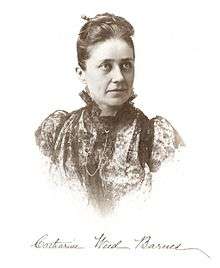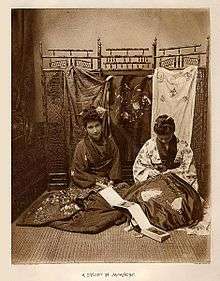Catharine Weed Barnes
| Catharine Weed Barnes | |
|---|---|
 Photographed by Edward S. Sterry (1890) | |
| Born |
Catharine Weed Barnes 10 January 1851 Albany, New York, United States |
| Died |
31 July 1913 Hadlow, England |
| Nationality | American |
| Known for | photographer |

Catharine Weed Barnes (10 January 1851 – 31 July 1913) [1] was an early American photographer who later lived in England. She was a strong supporter of women photographers.[2]
Early life and education
Catharine Weed Barnes was born in Albany, New York, the oldest child of well-to-do parents William Barnes and Emily P. (Weed) Barnes (daughter of the politician Thurlow Weed).[1][3] She attended Vassar College but her time was cut short by familial obligations.[4] In 1872, she went to Russia with her father, who was a delegate to an international congress.[1]
She took up photography in 1886 and in 1890 became an editor for American Amateur Photographer magazine, contributing a column entitled "Women's Work".[1][5] She later also contributed to Frank Leslie's Weekly.[1] She joined several associations that were usually reserved for men, including the National Photographers' Association of America and the Camera Club of New York.[1][6] Her work, including prints and magic lantern slides, won prizes at amateur photography exhibitions.[1][7]
In 1892, she travelled to Britain to address the Photographic Convention of the United Kingdom in Edinburgh. In London, she met Henry Snowden Ward, an editor of photography journals, who soon became her husband. She settled in England and took up editorial work for the journal The Photogram. She also illustrated several books by her husband with photographs she had taken, including Shakespeare's Town and Times (1896), The Canterbury Pilgrimages (1904), and The Real Dickens Land (1904).[6][8][9] Throughout her career, Barnes spoke in support to women in photography, insisting that their work should be judged according to the same criteria as those applied to men.[10]
Legacy
Barnes took some 10,000 photographs on glass plates negatives over the course of her career but only about a fifth are known to have survived. Archives of her work are held by the George Eastman Museum in Rochester, New York and by the Kent Archaeological Society in Maidstone, England. The latter collection features photographs Barnes made for her husband's books.[11]
References
- 1 2 3 4 5 6 7 Willard, Frances, and Mary Livermore, eds. A Woman of the Century: Fourteen Hundred-Seventy Biographical Sketches Accompanied by Portraits of Leading American Women in All Walks of Life. New York: Moulton, 1893, pp. 54-55.
- ↑ Leggat, Robert. "Women Pioneers of Photography", mpritchard.com. Retrieved 20 March 2013.
- ↑

- ↑ Rosenblum, Naomi. A History of Women Photographers, 1994.
- ↑ Johnson, William (1999). A History of Photography. Hohenzollerning 53, D-50672 Koln: Taschen GmbH. p. 380. ISBN 978-3-8228-4777-0.
- 1 2 3 "Catharine Weed Barnes Ward", Historic Camera. Retrieved 20 March 2013.
- ↑ Francis E. Willard; Mary A. Livermore, eds. Miss Catherine Weed Barnes. Great American Women of the 19th Century. 2005. Prometheus Books
- ↑ Ward, Henry Snowden; Ward, Catherine Weed (1896). Shakespeare's Town and Times. S. Low. Retrieved 20 March 2013.
- ↑ Ward, H. Snowden; Ward, Catharine Weed Barnes (1904). The Real Dickens Land with an Outline of Dickens's Life. Chapman and Hall. Retrieved 20 March 2013.
- ↑ Catharine Weed Barnes, "Photography from a Woman's Standpoint" address to the Society of Amateur Photographers of New York, 27 December 1889. Retrieved 20 March 2013.
- ↑ "Glass plate negatives made by Catharine (aka Catherine) Weed". Kent Archaeological Society. Retrieved 27 January 2016.
External links
| Wikimedia Commons has media related to Catharine Weed Barnes. |
- George Eastman Museum, Rochester, NY, Photography Collections Online, featuring almost 1,200 photographs taken in Britain by Weed